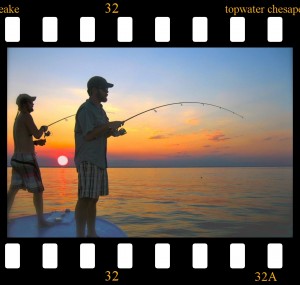 Lights! Action! Intensity! Get those video camera’s rolling. It’s time for adrenaline pumping surface action along the rocky shorelines and the grassy points of the Chesapeake Bay. The top-water bite is on! I’ve written a lot about where and when to cast top-water lures, but I haven’t said too much about choosing a good fishing rod for surface feeding stripers. Let’s fix that. Here are six tips for choosing the right top-water rod.
Lights! Action! Intensity! Get those video camera’s rolling. It’s time for adrenaline pumping surface action along the rocky shorelines and the grassy points of the Chesapeake Bay. The top-water bite is on! I’ve written a lot about where and when to cast top-water lures, but I haven’t said too much about choosing a good fishing rod for surface feeding stripers. Let’s fix that. Here are six tips for choosing the right top-water rod.
1. Spin It To Win It – Since it’s often windy on the Bay and surface lures are light and not very aerodynamic, I prefer a spinning outfit for top-water casting. There’s a trade off because casting rods are more accurate, but there’s nothing more frustrating than having to stop to pick out a backlash, especially while you’re drifting quickly past fish-holding cover. If need be, you can increase your accuracy with a spinning outfit by adding micro-guides, but standard guides work fine. Reduce your margin for error and go with the sissy stick. Read More!
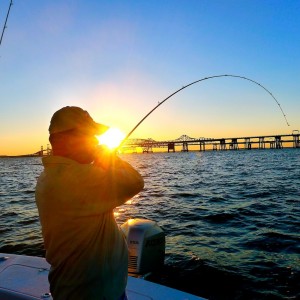 When it comes to selecting a rod, light tackle fishermen are rightfully very picky. Most of us get very specific about what we like. You’ll find several websites that have great information about choosing a multi-purpose fishing rod, but I don’t know of many that focus specifically on the best rods for casting lures on the Chesapeake Bay. There is always an element of personal choice when it comes to rod selection, and less experienced anglers should use basic and less-expensive equipment, but if you’re serious about the light tackle game, here are six things (and maybe a few more) you need to know:
When it comes to selecting a rod, light tackle fishermen are rightfully very picky. Most of us get very specific about what we like. You’ll find several websites that have great information about choosing a multi-purpose fishing rod, but I don’t know of many that focus specifically on the best rods for casting lures on the Chesapeake Bay. There is always an element of personal choice when it comes to rod selection, and less experienced anglers should use basic and less-expensive equipment, but if you’re serious about the light tackle game, here are six things (and maybe a few more) you need to know:
1. Baitcasting Benefits – Once you see a baitcaster used effectively for catching stripers, you’ll never go back to a spinning outfit. Baitcasters are appropriate for most jigging situations in the Chesapeake Bay. Wind and current can make a boat drift rapidly across a good jigging spot. As you drift across and away from the fish, your lure will be pulled up, over and above the strike zone. With a baitcaster, you simply press the thumb bar to let your lure fall back down to the proper depth. Unlike with a spinning reel, you don’t have to cast again. Keep in mind that, through most of the year, the bigger stripers are usually close to the bottom, so you increase your chances of catching them by keeping the lure where they are. Here’s a link to a video I shot in July a few years ago at the Bay Bridge. It shows some useful baitcasting techniques and includes some shots of resetting a lure into the strike zone. https://www.youtube.com/watch?v=sH_3rC0sZ-Y
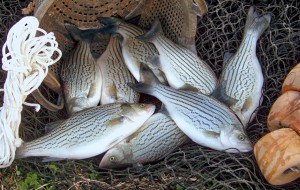 Number five: Aquaculture Accounts for Over FIFTY Percent of Stripers Sold – In fact, it’s closer to sixty percent. Hybrid striped bass production is one of the fastest growing forms of aquaculture in the United States. Annual production has increased over two-hundred percent in recent years as scientists refine efficient and highly productive ways to raise stripers. Commercial fishing for wild striped bass has a long history in Maryland, but don’t let anyone fool you into thinking you couldn’t eat stripers if they weren’t caught in the Chesapeake Bay. In fact, you’ll eat better if you eat farm-raised fish. Those of us who catch and eat fish right off the boat are used to great-tasting fish, but hybrid stripers have a slightly sweeter flavor and a more delicate texture than wild-caught fish. They don’t contain the high levels of mercury and PCBs found in Chesapeake Bay rockfish, so it’s safer to feed them to your family. Striped bass aquaculture is a sustainable method for providing healthy , high-quality fish to restaurants, grocery stores, and seafood markets. In stark contrast, a recent effort by the Department of Natural Resources to get wild-caught striped bass deemed sustainable in Maryland, failed. Read More!
Number five: Aquaculture Accounts for Over FIFTY Percent of Stripers Sold – In fact, it’s closer to sixty percent. Hybrid striped bass production is one of the fastest growing forms of aquaculture in the United States. Annual production has increased over two-hundred percent in recent years as scientists refine efficient and highly productive ways to raise stripers. Commercial fishing for wild striped bass has a long history in Maryland, but don’t let anyone fool you into thinking you couldn’t eat stripers if they weren’t caught in the Chesapeake Bay. In fact, you’ll eat better if you eat farm-raised fish. Those of us who catch and eat fish right off the boat are used to great-tasting fish, but hybrid stripers have a slightly sweeter flavor and a more delicate texture than wild-caught fish. They don’t contain the high levels of mercury and PCBs found in Chesapeake Bay rockfish, so it’s safer to feed them to your family. Striped bass aquaculture is a sustainable method for providing healthy , high-quality fish to restaurants, grocery stores, and seafood markets. In stark contrast, a recent effort by the Department of Natural Resources to get wild-caught striped bass deemed sustainable in Maryland, failed. Read More!
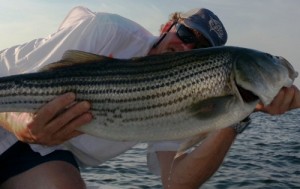 To share time-sensitive fishing information and relay real-time conditions on the water, I’ll be more active on Twitter. Last night at about 4:00 PM, I mentioned via Facebook that I would live-tweet a fishing trip starting at 5:30 PM. I’ll do this more often. Be assured that I won’t mention too many locations, but I’ll be specific about the patterns and techniques we encounter. I’ll also tweet pictures of the fish we’re catching, provide sonar shots, and share thoughts and details about hot lures and techniques. If you missed last night’s feed, you can read it on my Twitter page – @shawnkimbro. You can also follow me there to get the info live as it happens. I can’t do this all the time, but I’ll re-post last nights feed here, with some additional details and commentary inserted in italics. I’ve also cleaned up spelling and grammar since I use Google Voice instead of trying to type on my android touch-screen with wet hands. All the pictures (click the Twitter links) including the one to the left were tweeted live from the water.
To share time-sensitive fishing information and relay real-time conditions on the water, I’ll be more active on Twitter. Last night at about 4:00 PM, I mentioned via Facebook that I would live-tweet a fishing trip starting at 5:30 PM. I’ll do this more often. Be assured that I won’t mention too many locations, but I’ll be specific about the patterns and techniques we encounter. I’ll also tweet pictures of the fish we’re catching, provide sonar shots, and share thoughts and details about hot lures and techniques. If you missed last night’s feed, you can read it on my Twitter page – @shawnkimbro. You can also follow me there to get the info live as it happens. I can’t do this all the time, but I’ll re-post last nights feed here, with some additional details and commentary inserted in italics. I’ve also cleaned up spelling and grammar since I use Google Voice instead of trying to type on my android touch-screen with wet hands. All the pictures (click the Twitter links) including the one to the left were tweeted live from the water.
 Shawn Kimbro
Shawn Kimbro @ShawnKimbro 19h
Tweeting details of tonight’s fishing trip beginning 5:30 pm. #stormdodging
*I actually started a little earlier with a few preliminary details.
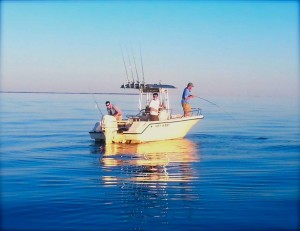 Hack [hak] (n) – A clever trick, skill, or shortcut to increase productivity and efficiency.
Hack [hak] (n) – A clever trick, skill, or shortcut to increase productivity and efficiency.
1. Find the bait first, then look nearby for the fish.
2. All things being equal, go with chartreuse.
3. Fish in areas where you can see the current moving.
4. The sneakier the angler, the bigger the fish.
5. Use dark colored lures in low light situations and rainy days.
6. Color contrasts attract fish. Read More!
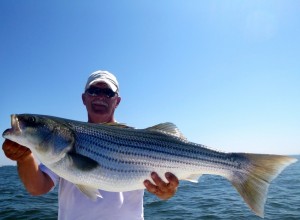 Congratulations to Rich Jenkins, 2013 Champion of the Kent Narrows Light Tackle Catch-&-Release Tournament. Rich fished with Jamie Clough, Jon Griffiths and me onboard my 27 Judge CC Thunder Road and won the tournament with a wide-shouldered 34-inch striper caught about 1:00 PM Saturday afternoon. Coming off the win, I thought it might be helpful to post some recommendations for catching bigger striped bass in Maryland’s portion of the Chesapeake Bay in June.
Congratulations to Rich Jenkins, 2013 Champion of the Kent Narrows Light Tackle Catch-&-Release Tournament. Rich fished with Jamie Clough, Jon Griffiths and me onboard my 27 Judge CC Thunder Road and won the tournament with a wide-shouldered 34-inch striper caught about 1:00 PM Saturday afternoon. Coming off the win, I thought it might be helpful to post some recommendations for catching bigger striped bass in Maryland’s portion of the Chesapeake Bay in June.
Topwater – Look around high-current points where there is access to deep water. Submerged rocks and other cover are a plus. Set up downstream and fan-cast into the direction of the current starting closest to shore. Look for the rip, that is a change in the waves around the point and work that area hard. On calm days, use a spook. In rougher water, try a big popper. Heddon Super Spooks, Lonely Angler Zipsters, and Stillwater Smackits are great lures for this time of year. Read More!


